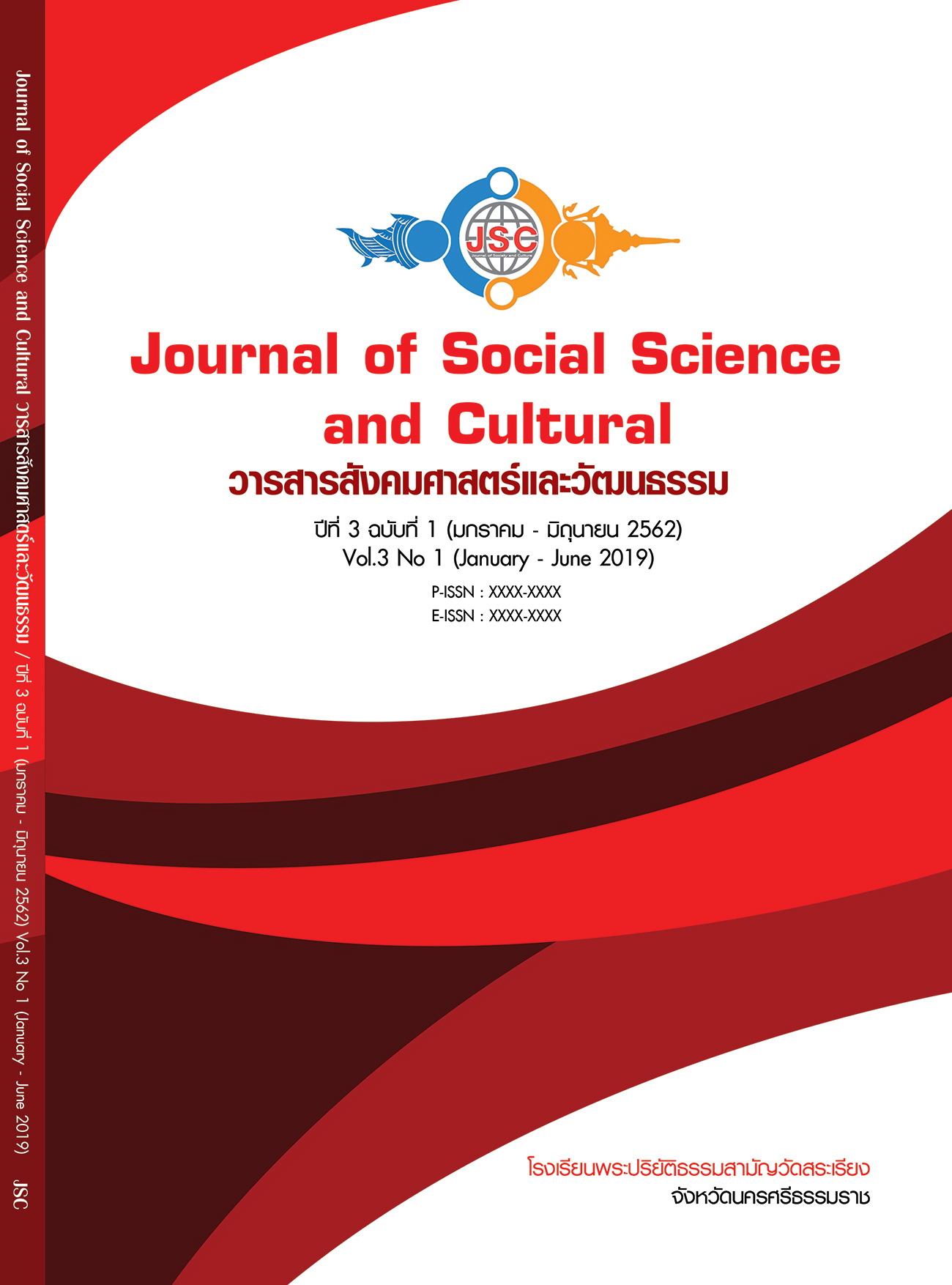FACTORS AFFECTING FOR DEVELOPMENT TO LIFE QUALITY OF THE ELDER IN KAMPEANGSOA SUB DISTRICT, MUEANG DISTRICT, NAKHON SI THAMMARAT PROVINCE
Main Article Content
Abstract
The objectives of this research were as follows: 1) To study of life quality development of elders, 2) To compare about life quality development of elders, and 3) To study the suggestions on life quality development of elders. The study was quantitative research by specific sampling questionnaire from the group sample of disables who age between 55-65 year old that live at Kampangsoa sub district, Mueang district, Nakhon Si Thammarat province more than 10 years for all the total sample 317 persons. Data were analyzed using statistic, percentage, average, standard deviation, t - test and F - test for presenting descriptive information in an overview The research found that 1) The life quality development of elders by overview was at moderate level ( = 3.29) when considered in each aspect from 5 parts such as 1.1) social welfare 1.2) health 1.3) environment 1.4) mind and 5) Social relations. 2) The comparative results on life quality development of elders found that the elders who had different from of gender, age, disable type and occupation so the life quality development. disables are the same. And is associated with a statisticant significant level .001. and 3) The suggestions and life quality development processing such as 3.1) the elders should consume food moderately and also benefit for health moreover exercise regularly, 3.2) the sub-district administration organization should create recreation activities, 3.3) the should be organized together in social activities by volunteering and practicing professional skills, 3.4) The sub - district administration organization should create green area for the elders to exercise and relax to accommodate more group activities with people in the community, and 3.5) The government should surrey and support seriously about the elders in the community for supply various equipment as needed for the elders as required for free.
Article Details
References
กรมกิจการผู้สูงอายุ. (2563). แนวโน้มสาเหตุและผลที่ตามมาของการมีอายุสูงขึ้นของประชากร. เรียกใช้เมื่อ 21 พฤศจิกายน 2563 จาก http://www.dop.go.th/th
กรมกิจการผู้สูงอายุ. (2563). ยุทธศาสตร์แผนผู้สูงอายุแห่งชาติ. เรียกใช้เมื่อ 21 พฤศจิกายน 2563 จาก http://www.dop.go.th/th
ชมพูนุท พรหมภักดิ์. (2556). การเข้าสู่สังคมผู้สูงอายุของประเทศไทย. กรุงเทพมหานคร: สํานักงานเลขาธิการวุฒิสภา.
ธนาคารแห่งประเทศไทย. (2563). ความท้าทายของภาวะสังคมผู้สูงอายุของประเทศไทย. เรียกใช้เมื่อ 21 พฤศจิกายน 2563 จาก https://www.bot.or.th/Thai/Pages/ default.aspx
บุญชม ศรีสะอาด. (2556). วิธีการทางสถิติสำหรับการวิจัย เล่ม 1. (พิมพ์ครั้งที่ 5). กรุงเทพมหานคร: สุวีริยาการพิมพ์.
ราชวิทยาลัยทันตแพทย์แห่งประเทศไทย. (2563). ประเทศไทยก้าวสู่สังคมผู้สูงอายุเกือบเต็มตัว. เรียกใช้เมื่อ 5 มกราคม 2563 จาก https://www.royalthaident.org/home/
สมคิด แทวกระโทก. (2560). แนวทางการพัฒนาคุณภาพชีวิตของผู้สูงอายุพื้นที่องค์การบริหารส่วนตำบลในเขตอำเภอจักราช จังหวัดนครราชสีมา. วารสารชุมชนวิจัย, 11(1), 158-170.
สํานักส่งเสริมและพิทักษ์ผู้สูงอายุ (สทส.) กระทรวงการพัฒนาสังคมและความมั่นคงของมนุษย์. (2563). นโยบายรัฐบาลด้านผู้สูงอายุ. เรียกใช้เมื่อ 5 มกราคม 2563 จาก http://www.oppo.opp.go.th /pages/law/law_06.html
สำนักงานสถิติจังหวัดนครศรีธรรมราช. (2563). ข้อมูลประชากรคนพิการ. เรียกใช้เมื่อ 5 มิถุนายน 2563 จาก http://nksitham.nso.go.th/index.php?option=com_ content&view=article&id=397:mindmap-older&catid=100:2012-01-09-07-04-24
สุทธิพงศ์ บุญผดุง. (2554). การพัฒนาคุณภาพชีวิตผู้สูงอายุในท้องถิ่นโดยใช้โรงเรียนเป็นฐาน ตามหลักเศรษฐกิจพอเพียง (ระยะที่ 1). กรุงเทพมหานคร: มหาวิทยาลัยราชภัฏสวนสุนันทา.
อารดา ธีระเกียรติกำจร. (2554). คุณภาพชีวิตผู้สูงอายุในเขตเทศบาลตำบลสุเทพ อำเภอเมือง จังหวัดเชียงใหม่. ใน วิทยานิพนธ์เศรษฐศาสตรมหาบัณฑิต สาขาวิชาเศรษฐศาสตร์. มหาวิทยาลัยเชียงใหม่.
Cronbach, L. J. (1990). Essentials of psychological testing. (5th ed.). New York: Harper Collins Publishers.
Krejcie, R. V. & Morgan, D. W. (1970). Determining Sample Size for Research Activities. Educational and Psychological Measurement, 30(3). 607-610.
Likert, R. (1967). The Method of Constructing and Attitude Scale. In Fishbeic, M (Ed.), Attitude Theory and Measurement (pp. 90-95). New York: Wiley & Son.
Schalock, L. R. (2004). The concept of quality of life: what we know and do not know. Journal of Intellectual Disability Research, 48(3), 203-390.


